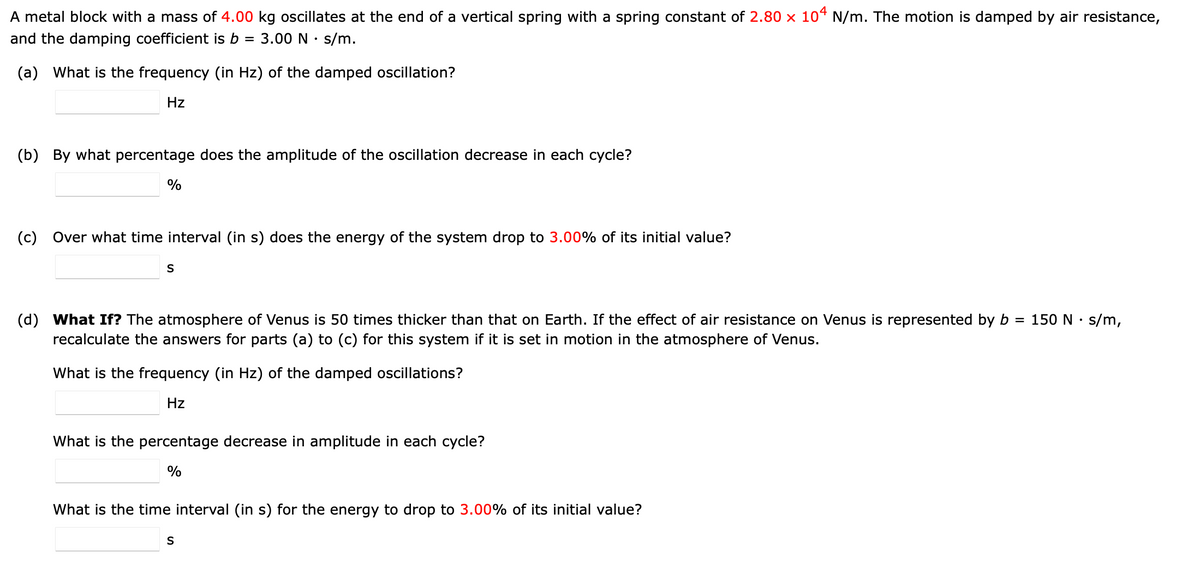Principles of Physics: A Calculus-Based Text
5th Edition
ISBN:9781133104261
Author:Raymond A. Serway, John W. Jewett
Publisher:Raymond A. Serway, John W. Jewett
Chapter12: Oscillatory Motion
Section: Chapter Questions
Problem 11OQ
Related questions
Question
need help with d

Transcribed Image Text:A metal block with a mass of 4.00 kg oscillates at the end of a vertical spring with a spring constant of 2.80 x 10“ N/m. The motion is damped by air resistance,
and the damping coefficient is b = 3.00 N • s/m.
(a) What is the frequency (in Hz) of the damped oscillation?
Hz
(b) By what percentage does the amplitude of the oscillation decrease in each cycle?
%
(c) Over what time interval (in s) does the energy of the system drop to 3.00% of its initial value?
S
(d) What If? The atmosphere of Venus is 50 times thicker than that on Earth. If the effect of air resistance on Venus is represented by b = 150 N · s/m,
recalculate the answers for parts (a) to (c) for this system if it is set in motion in the atmosphere of Venus.
What is the frequency (in Hz) of the damped oscillations?
Hz
What is the percentage decrease in amplitude in each cycle?
%
What is the time interval (in s) for the energy to drop to 3.00% of its initial value?
S
Expert Solution
This question has been solved!
Explore an expertly crafted, step-by-step solution for a thorough understanding of key concepts.
Step by step
Solved in 3 steps with 3 images

Knowledge Booster
Learn more about
Need a deep-dive on the concept behind this application? Look no further. Learn more about this topic, physics and related others by exploring similar questions and additional content below.Recommended textbooks for you

Principles of Physics: A Calculus-Based Text
Physics
ISBN:
9781133104261
Author:
Raymond A. Serway, John W. Jewett
Publisher:
Cengage Learning

Physics for Scientists and Engineers: Foundations…
Physics
ISBN:
9781133939146
Author:
Katz, Debora M.
Publisher:
Cengage Learning

Physics for Scientists and Engineers with Modern …
Physics
ISBN:
9781337553292
Author:
Raymond A. Serway, John W. Jewett
Publisher:
Cengage Learning

Principles of Physics: A Calculus-Based Text
Physics
ISBN:
9781133104261
Author:
Raymond A. Serway, John W. Jewett
Publisher:
Cengage Learning

Physics for Scientists and Engineers: Foundations…
Physics
ISBN:
9781133939146
Author:
Katz, Debora M.
Publisher:
Cengage Learning

Physics for Scientists and Engineers with Modern …
Physics
ISBN:
9781337553292
Author:
Raymond A. Serway, John W. Jewett
Publisher:
Cengage Learning

Physics for Scientists and Engineers
Physics
ISBN:
9781337553278
Author:
Raymond A. Serway, John W. Jewett
Publisher:
Cengage Learning

Classical Dynamics of Particles and Systems
Physics
ISBN:
9780534408961
Author:
Stephen T. Thornton, Jerry B. Marion
Publisher:
Cengage Learning

University Physics Volume 1
Physics
ISBN:
9781938168277
Author:
William Moebs, Samuel J. Ling, Jeff Sanny
Publisher:
OpenStax - Rice University